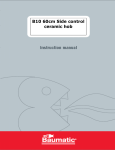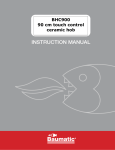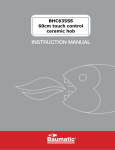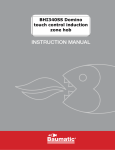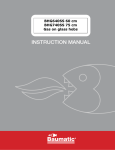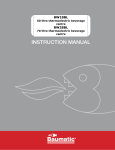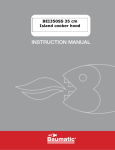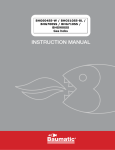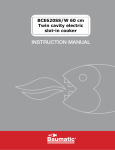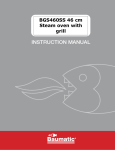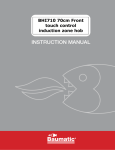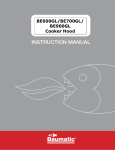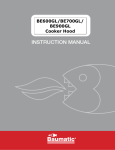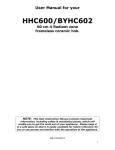Download Baumatic BHC602 hob
Transcript
BHC602 60 cm 4 Radiant zone frameless ceramic hob 1 User Manual for your Baumatic BHC602 60 cm 4 Radiant zone frameless ceramic hob. NOTE: This User Instruction Manual contains important information, including safety & installation points, which will enable you to get the most out of your appliance. Please keep it in a safe place so that it is easily available for future reference; for you or any person not familiar with the operation of the appliance. DD 27/06/11 2 Contents Environmental note 4 Important safety information 5–8 Specifications Product and aperture dimensions Product specifications Standard accessories Electrical details Ceramic hob surface layout Control panel 8 - 10 8 8 8 9 9 10 Using the ceramic hob Before first use Control knobs Switching on a cooking zone and setting a power level Residual heat indicators Hob guidelines 10 - 13 10 11 11 12 12 - 13 Cleaning and maintenance Cleaning the ceramic hob top After each use Cleaning table Using a ceramic hob scraper Using a specialist ceramic hob cleaner 13 - 15 13 14 14 14 15 Installation Positioning Unpacking the appliance Installing the appliance Electrical connection Connecting the mains supply cable Replacing the mains supply cable 15 15 16 16 18 19 21 My appliance isn’t working correctly 21 – 22 Contact details 23 - 21 - 16 – 18 - 19 - 20 3 Environmental note o The packaging materials that Baumatic uses are environmentally friendly and can be recycled. o Please discard all packaging material with due regard for the environment. 4 Important safety information Your safety is of the utmost importance to Baumatic. Please make sure that you read this instruction booklet before attempting to install or use the appliance. If you are unsure of any of the information contained in this booklet, please contact the Baumatic Advice Line. General Information o This appliance is designed for domestic household use and for the cooking and frying of domestic foodstuffs. o IMPORTANT: The adjacent furniture and all materials used in the installation must be able to withstand a minimum temperature of 85°C above the ambient temperature of the room it is located in, whilst in use. o Certain types of vinyl or laminate kitchen furniture are particularly prone to heat damage or discolouration at temperatures below the guidelines given above. o Any damage caused by the appliance being installed in contravention of this temperature limit, will be the liability of the owner. o Your new appliance is guaranteed against electrical or mechanical defects, subject to certain exclusions that are noted in Baumatic’s Conditions Of Guarantee. The foregoing does not affect your statutory rights. o The use of this appliance for any other purpose or in any other environment without the express agreement of Baumatic Ltd. will invalidate any warranty or liability claim. o You should not use this appliance to store items on or as a work surface. o No modifications to the appliance are permitted by Baumatic Ltd. o You should not store or place flammable or highly flammable liquids/materials on top of or near the appliance. Items made from aluminium, plastic or plastic film should also be kept away from the appliance, as they may fuse to the surface. o Repairs may only be carried out by Baumatic service engineers or their authorised service agents. 5 Child Safety o Baumatic strongly recommend that babies and young children are prevented from being near to the appliance and not allowed to touch the appliance at any time. During and after use, all surfaces will become hot. o If it is necessary for younger family members to be in the kitchen, please ensure that they are kept under close supervision at all times. o Older children should only be allowed to utilise the appliance when supervised. General Safety The appliance should only be installed and connected by a suitably qualified person. Care should be taken to ensure that the units and work surfaces that you build the appliance into, meet with the relevant standards. If you notice any scratches, splits or cracks in the ceramic glass, you should immediately switch off the appliance and disconnect it from your mains supply. Otherwise there is the risk of electric shock occurring. During use Any film or stickers that are present on the hob surface when it is delivered should be removed before use. Care should be used when utilising the appliance, otherwise there is a risk of burns being caused. o You should not allow the electrical connection cables to come into contact with the hob surface when it is hot or any hot cookware. o If fat and oil overheats, then it can ignite extremely quickly. For this reason, when cooking with fat and oil the appliance should not be left unattended. Make sure that all of the cooking zones are switched off after use. 6 Cleaning o Cleaning of the hob should be carried out on a regular basis. o IMPORTANT: Before attempting to clean the appliance, it should be disconnected from the mains and cool. o Great care should be taken whilst using this appliance and when following the cleaning procedure. o You should not use a steam jet or any other high pressure cleaning equipment to clean the appliance. Installation This appliance must be correctly installed by a suitably qualified person, strictly in accordance with the manufacturer’s instructions. Please see the specific section of this booklet that refers to installation. o Baumatic Ltd. declines any responsibility for injury or damage, to person or property, as a result of improper use or installation of this appliance. Declaration of conformity This appliance complies with the following European Directives: -2006/95/CE General regulations / Low tension -1935/2004/CE 90/128/EEC This appliance is suitable to come in contact with food -2004/108/CE Electromagnetic compatibility o The manufacturer declares that the hob is built using certified materials and requires the appliance to be installed in accordance with the standards currently in force. This appliance must be used by a trained person for domestic purposes only. To avoid damaging your appliance o The ceramic glass can be damaged by objects falling onto it. o The ceramic glass edge can be damaged by knocks from cookware. o Cast iron and cast aluminium cookware with damaged bases may scratch the ceramic surface if they are dragged across it. 7 o Pans should be lifted on and off the hob surface and not dragged. o Cooking zones should not be switched on without cookware placed on it. Also the cookware should not be empty. Specifications Product dimensions: Depth: Width: Height: 520 mm 590 mm 55 mm Aperture dimensions: Depth: Width: 495 mm 565 mm Product specifications: o o o o o 2 x 1.80 kW radiant zones 2 x 1.20 kW radiant zones Side control operation 4 x Individual residual heat indicators Frameless Standard accessory o Ceramic hob scraper 8 Electrical details Rated Voltage: Supply Connection: Max Rated Inputs: Mains Supply Lead: 230 Vac 50 Hz 30 A (double pole switched fused outlet with 3mm contact gap) 6.00 kW 3 core x 4 mm² (not supplied) For future reference please record the following information which can be found on the rating plate and the date of purchase which can be found on your sales invoice. The rating plate of your hob is located on the underneath of the appliance. Therefore it is a good idea to record this information before you install your appliance. Model Number ………………………………. Serial Number ………………………………. Date of Purchase ………………………………. Ceramic hob surface layout A B C = = = 1.80 kW radiant zones 1.20 kW radiant zones Control panel 9 Control panel Using the ceramic hob Before first use IMPORTANT: You should clean the ceramic hob surface (see “Cleaning and maintenance” section). o You should switch on one cooking zone at a time, for 5 minutes at the maximum setting. This will help to eliminate any new smell that exists and evaporate any humidity that has formed on the heating elements during transit. o Do not burn off more than one zone at once. o You must place a saucepan filled half full with cold water on each zone as you burn it off. 10 Control knobs o All operations are performed by means of the 4 control knobs that can be found on the right hand side of the hob top. o The control knob should be turned anti-clockwise or clockwise to select a heating level. The dots around the outside of each control knob indicate the power level that you have set the zone to. o A marking to the top right of each control knob, indicates which cooking zone that it controls. Switching on a cooking zone and setting a power level o Turn the control knob of the cooking zone that you wish to cook on. The control knob can be turned anti-clockwise or clockwise. o The smaller dots indicate the coolest cooking zone settings and the larger dots indicate the hottest cooking zone settings. o When you have finished cooking, make sure that you turn the control knob to the OFF position. 11 Residual heat indicators o To the left of each control knob, there is a residual heat indicator for the cooking zone that it controls. o After turning a cooking zone on, when the temperature of the zone goes above 60°C the corresponding residual heat indicator neon will switch on. o After turning a hob zone off, the residual heat indicator neon will stay on. This means that the zone has not been switched off for more than 35 minutes since last use. Therefore it is more likely that the temperature of the zone is still hot enough to cause injury. o After 35 minutes, from the zone being switched off, the residual heat indicator neon will turn off. o IMPORTANT: The residual heat indicator will disappear if your mains supply is cut. o IT IS STILL POSSIBLE TO BURN YOURSELF ON A HOB ZONE, EVEN WHEN THE TEMPERATURE OF IT HAS DROPPED BELOW 60°C. Hob guidelines o The first few times the hob top is used, it may give off an acrid, burning smell. This smell will disappear completely with repeated use. o The worktop is fitted with cooking areas of different diameter and power. o The positions where the heat will radiate from are clearly marked on the hob top. The saucepans must be positioned exactly on these zones for efficient heating to occur. Pans should have the same diameter as the cooking zone that they are being used on. o You should not use saucepans with rough bases, as this can scratch the ceramic surface. o Before use, make sure that the bases of the saucepans are clean and dry. o When cold, the base of the pans should be slightly concave, as they expand when hot and lie flat on the surface of the hob. This will allow the heat to transfer more easily. 12 o The best thickness for the base of the pans is 2 – 3 mm of enamelled steel and 4 – 6 mm for stainless steel with sandwich type bases. o If these rules are not followed, then there will be a great loss of heat and energy. Heat not absorbed by the saucepan, will spread to the hob, frame and surrounding cabinets. o Preferably cover pans with a lid to permit cooking at a lower heat. o Always cook vegetables and potatoes, etc. in as little water to reduce cooking times. o Food or liquid that has high sugar content may damage the hob top if it comes into contact with the ceramic hob surface. Any spillages should be wiped up immediately, however this may not prevent the hob surface from becoming damaged. o IMPORTANT: The ceramic hob surface is tough; however it is not unbreakable and can be damaged. Especially if pointed or hard objects are allowed to fall on it with some force. o DO NOT USE THE HOB IF THE SURFACE BECOMES BROKEN OR CRACKED. YOU SHOULD CONTACT THE CUSTOMER CARE DEPARTMENT IMMEDIATELY. Cleaning and maintenance Cleaning operations must only be carried out when the hob is cool. The appliance should be disconnected from your mains supply before commencing any cleaning process. Cleaning the ceramic hob top Any residues that are left on the hob top surface from cleaning agents will damage it. You should remove any residues with warm water mixed with a little washing up liquid. Abrasive cleaners or sharp objects will damage the hob surface; you should clean it using warm water mixed with a little washing up liquid. 13 You may find it easier to clean some deposits whilst the hob surface is still warm. However you should take care not to burn yourself if cleaning the hob surface when it is still warm. After each use o Wipe the appliance over with a damp cloth. o Dry the appliance by rubbing the surface with a clean cloth. Cleaning table Sugar or food/liquid containing sugar Tin foil or plastic Yes Remove when the appliance has cooled down? No Yes No Fat splashes No Yes Metallic discolouration Water splashes or water rings No Yes No Yes Type of deposit Remove Immediately? What should I use to remove the deposit? Ceramic hob scraper Ceramic hob cleaner Ceramic hob cleaner Ceramic hob cleaner Ceramic hob scraper Using a ceramic hob scraper It is possible to purchase a ceramic hob scraper. The following guidelines should also be followed when using the ceramic hob scraper:- o The scraper should be placed on the ceramic surface at an angle. o Residues should be removed by sliding the blade carefully over the ceramic surface. 14 o The ceramic surface should be wiped with a damp cloth that has been placed in warm water mixed with a small amount of washing up liquid. o Dry the appliance by rubbing the surface with a clean cloth. Using a specialist ceramic hob cleaner o It is possible to cleaner/conditioner. purchase a specialist ceramic hob o You should follow the instructions given by the manufacturer of the specialist ceramic hob cleaner. You should ensure that it is suitable for use on your appliance. Installation The installation must be carried out by a suitably qualified person, in accordance with the current version of the following. o UK Regulations and Safety Standards or their European Norm Replacements. o Building Regulations (issued by the Department of the Environment). o Building Standards (issued by the Scottish Development Department). o IEE Wiring Regulations. o Electricity At Work Regulations. Positioning The adjacent furniture must be able to withstand a minimum temperature rise of 85°C above the ambient temperature of the room it is located in, during periods of use. This appliance is classified as Class 3 and therefore is to be built into a kitchen unit (depending on size) or 600 mm worktop that is at least 30 mm thick. The following minimum clearance distances must be observed:o 700 mm between the hob surface and the underside of any horizontal surface above it. o 50 mm clearance around the front, back and sides of the appliance, measured from the cut out. 15 o If the hob is positioned so that the right or left hand side of the appliance will be near to the edge of a kitchen unit. There must be a gap of at least 150 mm between the side of the hob and the vertical surface of any kitchen unit that is made of a combustible material. If the vertical surface is made of a non-combustible material, then 55 mm clearance is sufficient. HOWEVER sufficient space must be allowed for saucepan handles to be turned and for saucepans to be used safely. Unpacking the appliance When unpacking the appliance please check that the following items are contained within the packaging:1 1 1 4 4 Hob Installation and instruction manual Guarantee card Fixing brackets Fixing screws Installing the appliance o Cut a hole in the worktop that corresponds with the drawing shown above. 16 o IMPORTANT: You must observe the ventilation requirements shown in the drawing above. In particular the 20 mm gap underneath the hob and the 5 mm gap underneath the front edge of the worktop. o IMPORTANT: There are ventilation holes around the outside of the hob. YOU MUST ensure that these holes are not blocked by the work top, when you put the hob into position (see drawing opposite). o Carefully turn the hob upside down and place it on a cushioned mat. o IMPORTANT: Do not use a silicon sealant to seal the appliance against the aperture. This will make it difficult to remove the hob from the aperture in future, particularly if it needs to be serviced. 17 o Carefully turn the hob back over and then gently lower it into the aperture hole that you have cut out. o There are holes on the base or the sides of the hob that you can fix the four brackets to. There are three holes in each one of the brackets. o You should place the bracket on the underneath of the hob, in a position that is appropriate for the aperture that you have cut out. Using the screws provided, fix the bracket to the hob. These screws MUST be securely tightened. Electrical connection This appliance must be installed by a qualified person in accordance with the latest edition of the I.E.E. Regulations and in compliance with the manufacturer's instructions. Before connecting the appliance, make sure that the supply voltage marked on the rating plate corresponds with your mains supply voltage. WARNING: THIS APPLIANCE MUST BE EARTHED. o This appliance must be wired into a 30 a double pole switched fused spur outlet, having 3 mm contact separation and placed in an easily accessible position adjacent to the appliance. It should not be located above the appliance and no more than 1.25m away from it. 18 o The spur outlet must still be accessible even when your hob is located in its operating position. o Cable type: H05 RRF 3 core x 4 mm² Connecting the mains supply cable o The mains terminal block is located on the underside of the hob and the terminals are accessible by removing the terminal block cover by removing the cover screw. 19 o The cable connections must be in accordance with the diagram located on the bottom of the hob (see above). o You should use a good quality screwdriver to carefully, fully tighten ALL of the terminal screws. o If when the hob is first switched on, only two of the zones work, you should recheck that the terminal screws are all fully tightened. This should be done before contacting the Baumatic Customer Care Department. o IMPORTANT: The appliance must NOT be connected to the mains supply by means of a 13A plug and socket. o The cable can be looped if necessary, but make sure that is not Kinked or trapped when the hob is in position. Care must be taken to avoid the cable being in contact with hot parts of the appliance. 20 Replacing the mains supply cable If the mains supply cable is damaged, then it must be replaced by an appropriate replacement. The mains supply cable should be replaced in accordance with the following instructions: o Switch the appliance off at the socket. o Open the terminal block on the underside of the hob. o Unscrew the terminal screws fixing the cable. o Replace the cable with one of the same length and in accordance with the specification given on page 19. o The “green-yellow” earth wire must be connected to the terminal . It must be about 10 mm longer than the live and marked neutral wires. o The “blue” neutral wire must be connected to the terminal marked with letter (N) - the live wire must be connected to the terminal marked with letter (L). My appliance isn’t working correctly o The cooking zones are not functioning or will not switch on. * Check that the mains electrical supply to the appliance is correct and working. Check the mains fuse. o The residual heat indicator has not come on after I have switched a cooking zone off. * The cooking zone has only been turned on for a short period of time; therefore it did not go above 60°C. * IMPORTANT: If the cooking zone does appear to be hotter than 60°C and the residual heat indicator has not come on, you should call the Baumatic Customer Care Department. o A humming sound is heard when a cooking zone is selected. * This is normal; the sound will disappear when the zone heats up. 21 o The cooking zones have become discoloured. * This maybe caused by burnt on remnants of food. This will not affect the working of the appliance. However you should make sure that the cleaning instructions are being followed regularly. IMPORTANT: If your appliance appears not to be operating correctly, then you should disconnect it from your mains supply and then contact the Baumatic Customer Care Department on telephone number (0118) 933 6911. DO NOT ATTEMPT TO REPAIR THE APPLIANCE YOURSELF. Please note that if an engineer is asked to attend whilst the product is under guarantee and finds that the problem is not the result of an appliance fault, then you may be liable for the cost of the call out charge. The appliance must be accessible for the engineer to perform any necessary repair. If your appliance is installed in such a way that an engineer is concerned that damage will be caused to the appliance or your kitchen, then he will not complete a repair. This includes situations where appliances have been tiled in, sealed in with sealant, have wooden obstructions placed in front of the appliance, like plinths. Or any installation other than the one specified by Baumatic Ltd. has been completed. Please refer to the conditions of guarantee that appear on the warranty card that you receive with the appliance. IMPORTANT: Baumatic Ltd. operates a policy of continuous improvement and reserves the right to adjust and modify its products without prior notification. 22 United Kingdom Baumatic Ltd., Baumatic Buildings, 6 Bennet Road, Reading, Berkshire RG2 0QX United Kingdom Czech Republic Baumatic CR s.r.o. Lípovà 665 460 01 Liberec 4 Czech Republic Sales Telephone (0118) 933 6900 Sales Fax (0118) 931 0035 Customer Care Telephone (0118) 933 6911 Customer Care Fax (0118) 986 9124 Spares Telephone (01235) 437244 Advice Line Telephone (0118) 933 6933 www.baumatic.cz E-mail: [email protected] [email protected] [email protected] [email protected] Website: www.baumatic.co.uk Republic of Ireland Service Telephone 1-890 812 724 Spares Telephone 091 756 771 +420 483 577 200 Slovakia Baumatic Slovakia, s.r.o. Galvániho 7/D Slovakia +421 255 640 618 Germany Baumatic Gmbh Lilienthalstrasse 1 320 52 Herford Deutschland +49 5221 694 99-0 www.baumatic.de Italy Baumatic Italia S.R.L. Via Galvani N.3 35011 Campodarsego (PD) +3904 9920 2297 www.baumatic.it Holland Baumatic Benelux B.V. Grindzuigerstraat 22 1333 MS ALMERE Nederland +3136 549 1555 www.baumatic.nl 23 24
























